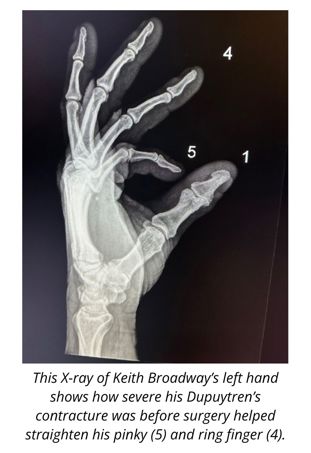
“I had a crooked finger, that’s what I tell everyone,” said Keith Broadway, a retiree from Waupun who suffered from Dupuytren’s contracture on his left hand. But Keith was being humble when he called his finger ‘crooked.’ Dupuytren’s contracture causes one or more fingers to bend toward the palm, and Keith’s left pinky was curled drastically, nearly pointing downward. His ring finger was also starting to contract.

“It started very slowly and got worse,” Keith said. He retired from the box-making industry about three years ago and thinks the Dupuytren’s contracture started shortly after that. It got noticeably worse as he was recovering from a torn rotator cuff and wasn’t using his left arm as much.
Keith uses his left hand for a lot of things, and as his Dupuytren’s contracture worsened, he found himself adapting or giving up activities he loved – like shooting hoops with his grandkids, woodworking, stacking wood and bowling.
“I had already given up bowling, but we always go as a family around Christmas,” Keith shared. “So, this winter I had to bowl right-handed, which was a lot worse!”
It was also nearly impossible for Keith to put on a glove when he helped his neighbors milk cows, so he started buying bigger gloves.
“I just dealt with it,” Keith recalled. But his daughter Jessie, a senior radiologic technologist at Orthopedics & Sports Medicine BayCare Clinic, saw his fingers curling and encouraged her dad to get it checked out.
“The first time she noticed it, I made a joke and said, ‘But Jess, you know what? I can carry a bucket without even having to hang on to it!’”
Dupuytren’s Contracture Release Surgery
Keith asked his doctor about his fingers and was referred to a specialist in Madison who took X-rays and told Keith he would need surgery. Jessie persuaded him to come to Green Bay and see Dr. Andrew Kirkpatrick, a board-certified orthopedic surgeon and fellowship-trained hand specialist, whom she works with at Orthopedics & Sports Medicine BayCare Clinic.
“He was terrific,” Keith said. And, as someone who doesn’t appreciate a doctor that overpromises results, Keith admired Dr. Kirkpatrick’s realistic approach during their first appointment.
“He said ‘That’s bad, I’m not going to get it 100% and you may lose feeling on the inside of that finger,’” Keith recalled.
A few weeks after his first appointment, Keith returned for a Dupuytren’s contracture release surgery. When Dr. Kirkpatrick walked in, he laughed a little when he saw Keith reading the latest copy of Wisconsin - Outdoor News.
“He said, ‘Oh, a newspaper?! I haven’t seen one of those in years,’” Keith said with a chuckle. “But then he saw what it was, and now I think he’s subscribed to the online version.”
Interactions like that with Dr. Kirkpatrick and his team helped Keith feel more at ease.
“I think that's very important because if you're nervous about surgery and then the people come in and they're all very serious, I think that makes it worse,” he said.
Keith’s only regret about his surgery is that he didn’t have it done as soon as the contracture started happening.
“If my pinky finger had only been as bad as my ring finger was when I had the surgery done, my hand would have been back to normal in a couple of weeks,” Keith said.
Only two months after Dr. Kirkpatrick performed Keith’s Dupuytren’s contracture release surgery, he hasn’t lost any feeling and both of his fingers are back to at least 90% straight.
“I’m super happy and it’s better than I anticipated,” Keith said. “I wish I had done it sooner because it would probably be even better.”
Physical Therapy Helps Keith Regain Strength
Keith will wear a splint overnight for 8-9 months after his surgery and has been doing his physical therapy sessions back home in Waupun. He credits his physical therapist for trusting Dr. Kirkpatrick’s therapy regimen, even though she was a little nervous at first. She had never worked with a patient of Dr. Kirkpatrick’s before.
“She was looking at the sheet with all of the steps that we were supposed to do, and she followed them by the book,” Keith said. “There were some things I think that she was going to take with her, too, that were different than what she’d seen from other doctors.”
Keith’s physical therapist even called Dr. Kirkpatrick to ask a question about his protocol and Keith’s progress at one point. Contrary to her prior experience with other doctors, Dr. Kirkpatrick took her call and helped her out.
Keith and Jessie believe the combination of Dr. Kirkpatrick’s clear, concise physical therapy instructions and his physical therapist’s encouragement have helped him recover better than expected.
“I think physical therapy is very important. You’re only going to get good results if you follow up and keep doing what your doctor wants you to do,” Keith said.
He’s already back to shooting hoops, wearing the correct size gloves, and stacking wood with both hands. If he sticks with his physical therapy, Keith is hopeful he’ll be bowling with his left hand again by Christmas.